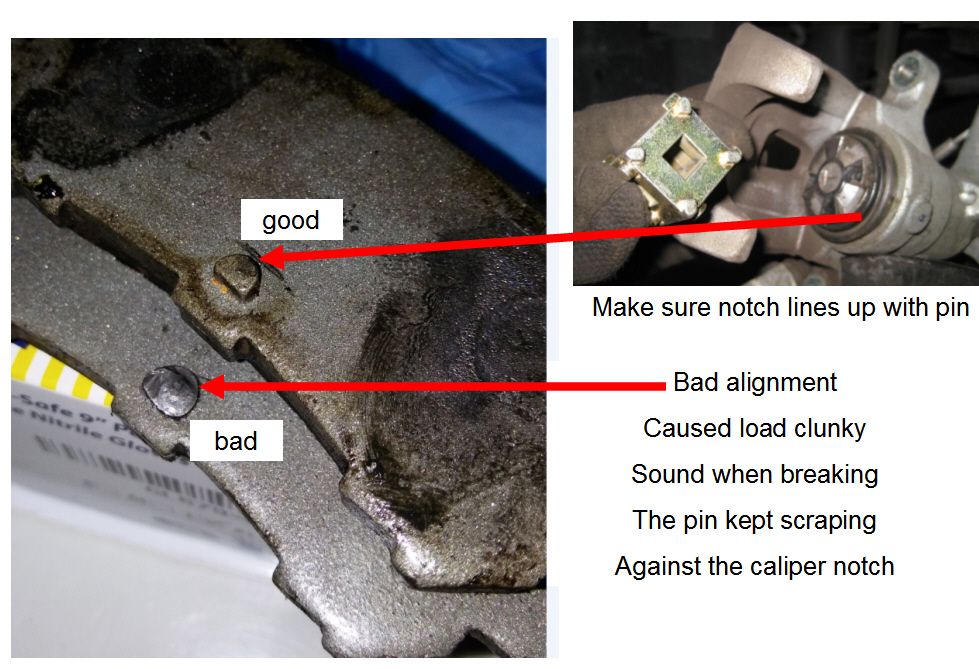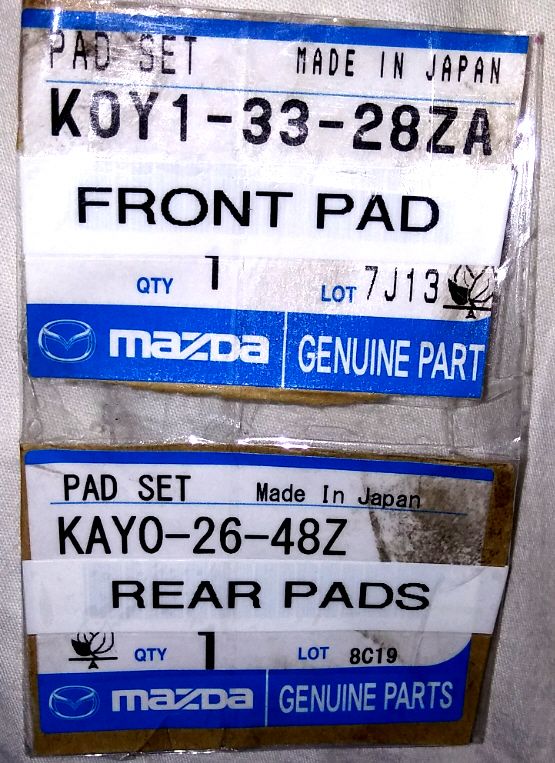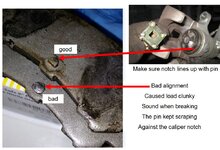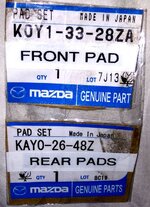You are using an out of date browser. It may not display this or other websites correctly.
You should upgrade or use an alternative browser.
You should upgrade or use an alternative browser.
Guide Maintenance Mode for 2016 / 2017 CX-5 electronic brakes
- Thread starter tomcat1446
- Start date
loud metal clunking sound when braking
just a heads up you guys, I didn't properly align the caliper notch with the pin on the rear pads and got a loud metal clunking sound when braking.
I disassembled the brakes and found out what I did wrong, I didn't do the slight adjustment to line the caliper notch with the pad pin..
Is there a visual mark of where the notches have to be ? It's a blind mate when the caliper goes over the pads so there's no visual to make sure they are exactly lined up... thoughts ?

Sidenote: I find the OEM brake pads (the ones made from Japan, not the Mazda Value ones) to be the best in stopping power,
I tried the Wagner Thermoquiet Ceramic pads , although they were quiet, I found them to have very subpar stopping power and they felt mushy when braking hard
Mazda 2016 CX-5 front pads (Made in Japan) K0Y1-33-28ZA
Mazda 2016 CX-5 rear pads (Made in Japan) KAY0-26-48Z

just a heads up you guys, I didn't properly align the caliper notch with the pin on the rear pads and got a loud metal clunking sound when braking.
I disassembled the brakes and found out what I did wrong, I didn't do the slight adjustment to line the caliper notch with the pad pin..
Is there a visual mark of where the notches have to be ? It's a blind mate when the caliper goes over the pads so there's no visual to make sure they are exactly lined up... thoughts ?
Sidenote: I find the OEM brake pads (the ones made from Japan, not the Mazda Value ones) to be the best in stopping power,
I tried the Wagner Thermoquiet Ceramic pads , although they were quiet, I found them to have very subpar stopping power and they felt mushy when braking hard
Mazda 2016 CX-5 front pads (Made in Japan) K0Y1-33-28ZA
Mazda 2016 CX-5 rear pads (Made in Japan) KAY0-26-48Z
Attachments
Last edited:
- :
- CX-9 Signature
Why not just buy an ODBII Scan Tool with Electronic System Actuation & Reset Functionality and simply reset the EPB from the scanner before manually retracting the calipers and then go finish your brake job. Besides, if you are replacing pads, then EPB must be reset anyway to re-index pad location relative to the EPB motor - if the system does not re-learn the air gap between the two on its own.
ak_cx5
Member
- :
- 2023 Mazda CX-5 2.5 S Select
My CX-5 is a 2018 and had squeaking coming from the rear brakes when I would first start driving after it sat for awhile. They would squeak when braking or even just rolling along at speeds under 10mph. Warm or cold temps wouldn't matter. Eventually it would go away once the brakes warmed up, but always came back after they cooled down again. None the less it was driving me CRAZY coming from my 1 year old car that only has 7K miles on it. I took it to the dealership and they told me the pads were still over 95% and that it was "normal" for this kind of car. They said they could try resurfacing the rotors for $$$. I called major lazy BS so decided to change the pads myself to see if it helped and guess what, it did!
Thanks to this thread I was able to do the whole pad replacement process myself so I really appreciate all the comments everyone made. I've changed brake pads before, but never with an EPB so I was a little apprehensive. Knowing about maintenance mode was extremely helpful. I made sure to change the hardware clips and use brake grease because I really think those were the problem, not the pads themselves. I still changed the pads just to be sure. I believe Mazda uses semi-metallic pads which could also be contributing to the noise, but the front brakes never make noise so it didn't add up to me. I also owned a 2014 Mazda 3 GT before this car and it never made noise either.
After I changed the pads and got everything put back together I went to take the car out of maintenance mode and the EPB motor ran for what seemed like way too long and then it just stopped and the yellow and red parking brake warning lights stayed on the dash. After taking the wheels off again and taking a look I remembered that when I had compressed the piston back it left a small gap between the new pad and the piston (even with brand new thickness pads). All I did was compress straight back, making sure the notches in the piston were north/south so they would line up with the pin on the back of the pad, so I couldn't understand why it wasn't working! I thought maybe the EPB motor was broken at first (of course blame it on the car, not the user, haha). I decided to watch the EPB motor while it was trying to re-engage and I noticed it would just spin the piston around and it wasn't actually making contact with the pad or grabbing the pin. So I took the caliper off again, lined up the piston notch, and then bolted the caliper back on. This time, before I turned off maintenance mode, I pressed the brake pedal down so that it would compress the piston up against the pad and lock the pin and the piston notch in place vs. leaving the gap like the first time. When I turned off maintenance mode it caught the pin and worked like a charm! Apparently when the EPB motor tries to compress the piston and close that gap, it can cause the piston head to spin and take the notch and pin out of its original alignment. This prevents the piston from making full contact with the pad and the system thinks there is something wrong with the EPB.
I had no experience with EPB before, so this was new for me. I seriously panicked a little when I couldn't get maintenance mode to go off so figured I'd share my experience just in case someone else has the same problem.
Thanks to this thread I was able to do the whole pad replacement process myself so I really appreciate all the comments everyone made. I've changed brake pads before, but never with an EPB so I was a little apprehensive. Knowing about maintenance mode was extremely helpful. I made sure to change the hardware clips and use brake grease because I really think those were the problem, not the pads themselves. I still changed the pads just to be sure. I believe Mazda uses semi-metallic pads which could also be contributing to the noise, but the front brakes never make noise so it didn't add up to me. I also owned a 2014 Mazda 3 GT before this car and it never made noise either.
After I changed the pads and got everything put back together I went to take the car out of maintenance mode and the EPB motor ran for what seemed like way too long and then it just stopped and the yellow and red parking brake warning lights stayed on the dash. After taking the wheels off again and taking a look I remembered that when I had compressed the piston back it left a small gap between the new pad and the piston (even with brand new thickness pads). All I did was compress straight back, making sure the notches in the piston were north/south so they would line up with the pin on the back of the pad, so I couldn't understand why it wasn't working! I thought maybe the EPB motor was broken at first (of course blame it on the car, not the user, haha). I decided to watch the EPB motor while it was trying to re-engage and I noticed it would just spin the piston around and it wasn't actually making contact with the pad or grabbing the pin. So I took the caliper off again, lined up the piston notch, and then bolted the caliper back on. This time, before I turned off maintenance mode, I pressed the brake pedal down so that it would compress the piston up against the pad and lock the pin and the piston notch in place vs. leaving the gap like the first time. When I turned off maintenance mode it caught the pin and worked like a charm! Apparently when the EPB motor tries to compress the piston and close that gap, it can cause the piston head to spin and take the notch and pin out of its original alignment. This prevents the piston from making full contact with the pad and the system thinks there is something wrong with the EPB.
I had no experience with EPB before, so this was new for me. I seriously panicked a little when I couldn't get maintenance mode to go off so figured I'd share my experience just in case someone else has the same problem.
Last edited:
- :
- Plano, Texas, USA
Thanks for sharing your experience. It definitely would help those who want to DIY on rear brake pad replacement with EPB.⋯ I had no experience with EPB before, so this was new for me. I seriously panicked a little when I couldn't get maintenance mode to go off so figured I'd share my experience just in case someone else has the same problem.
- :
- Plano, Texas, USA
Forgot to ask did you put a new set of OEM pads or aftermarket pads to resolve the squeaking issue? If it's an aftermarket set, which brand did you get?My CX-5 is a 2018 and had squeaking coming from the rear brakes when I would first start driving after it sat for awhile. They would squeak when braking or even just rolling along at speeds under 10mph. Warm or cold temps wouldn't matter. Eventually it would go away once the brakes warmed up, but always came back after they cooled down again. None the less it was driving me CRAZY coming from my 1 year old car that only has 7K miles on it. I took it to the dealership and they told me the pads were still over 95% and that it was "normal" for this kind of car. They said they could try resurfacing the rotors for $$$. I called major lazy BS so decided to change the pads myself to see if it helped and guess what, it did!
......... I decided to watch the EPB motor while it was trying to re-engage and I noticed it would just spin the piston around and it wasn't actually grabbing the pin. So I took the caliper off again, lined up the piston notch, and then bolted the caliper back on. This time, before I turned off maintenance mode, I pressed the brake pedal down so that it would compress the piston up against the pad and lock the pin and the piston notch in place vs. leaving the gap like the first time. When I turned off maintenance mode it caught the pin and worked like a charm! Apparently when the EPB motor tries to compress the piston and close that gap, it can cause the piston head to spin and take the notch and pin out of its original alignment. This prevents the piston from making full contact with the pad and the system thinks there is something wrong with the EPB.
I had no experience with EPB before, so this was new for me. I seriously panicked a little when I couldn't get maintenance mode to go off so figured I'd share my experience just in case someone else has the same problem.
this is very helpful !!! I think this happened to me , see my post #22 above, I didn't know I had to compress the brake first befire turning off maintenance mode,
my notch did not line up with brake pad pin and I kept hearing a cracking noise when I pressed the brakes as I drove.
It turned out the notch was slightly un-aligned with the pin as you can see in the photos.
No where in the Mazda procedures does it say that you have to press the brakes before disengaging the maintenance mode, but it defintely makes sense to do it..
thanks AK-CX5 for heads up!!!!!!! it'll help a lot of members I think.
Last edited:
ak_cx5
Member
- :
- 2023 Mazda CX-5 2.5 S Select
Forgot to ask did you put a new set of OEM pads or aftermarket pads to resolve the squeaking issue? If it's an aftermarket set, which brand did you get?
Sorry for the late response yrwei52. I did not replace them with Mazda pads because, from what I've read, they are semi metallic and more prone to squeaking. It's so weird because the front ones have been just fine since I bought the car. I ended up going with ceramic replacements on the rears. The kind I got are Power Stop 17-1846 Z17 Evolution Plus Premium Ceramic Brake Pads. You can get them on Amazon or RockAuto for about $30 and they come with new hardware clips. The Power Stop website tells you to do a "break-in" process after you've put them on which is basically a few hard slow downs and then driving around until they cool off to set the resin on the rotor. They were a perfect fit and so far they have been working great. No more squeaking, finally!
Last edited:
- :
- 2017 CX-5 GT AWD Premium
Did any of you disconnect the negative terminal on the battery after going into maintenance mode and before disconnecting the electrical connector to the electric parking brake motor gear unit? Or did you leave battery connected and have no issues disconnecting the EPB connector?
I looked at the 2018 CX5 workshop manuals posted here: https://www.mazdas247.com/forum/showthread.php?123864503-Workshop-Manuals-for-2018-CX-5
After going to the dropbox link provided by Schatzi0217, I navigated to "Workshop Manuals" -> "Brakes" -> "Conventional Brake System". In that folder, I viewed the "REAR BRAKE DISC REMOVAL INSTALLATION.PDF" and "REAR BRAKE MOUNTING SUPPORT REMOVAL INSTALLATION.PDF" files.
In both guides, the first 4 steps are the same:
1. Switch to maintenance mode.
2. Disconnect negative battery terminal.
3. Remove wheel.
4. Disconnect the electric parking brake motor gear unit connector.
Just wanted to see if anyone has done step 4 without doing step 2 and didn't have any issues.
Thanks.
I looked at the 2018 CX5 workshop manuals posted here: https://www.mazdas247.com/forum/showthread.php?123864503-Workshop-Manuals-for-2018-CX-5
After going to the dropbox link provided by Schatzi0217, I navigated to "Workshop Manuals" -> "Brakes" -> "Conventional Brake System". In that folder, I viewed the "REAR BRAKE DISC REMOVAL INSTALLATION.PDF" and "REAR BRAKE MOUNTING SUPPORT REMOVAL INSTALLATION.PDF" files.
In both guides, the first 4 steps are the same:
1. Switch to maintenance mode.
2. Disconnect negative battery terminal.
3. Remove wheel.
4. Disconnect the electric parking brake motor gear unit connector.
Just wanted to see if anyone has done step 4 without doing step 2 and didn't have any issues.
Thanks.
Last edited:
ak_cx5
Member
- :
- 2023 Mazda CX-5 2.5 S Select
I never disconnected the battery after putting in maintenance mode and didn't have any issues. But I never disconnected the parking brake motor connector either. Not sure why you'd need to do that other than extra extra precaution. Wouldn't hurt if you did, but I didn't need to.
- :
- Plano, Texas, USA
I agree. In theory there's no need to disconnect negative terminal and EPB motor electrical connector. Both procedures are provided to prevent activating EPB motor accidentally during the brake pad replacement. But I really can't see how though. It definitely wouldn't hurt to disconnect both of them, but as lazy as I am, I'd only disconnect EPB motor connector at most when I'm doing rear brake job on my CX-5.I never disconnected the battery after putting in maintenance mode and didn't have any issues. But I never disconnected the parking brake motor connector either. Not sure why you'd need to do that other than extra extra precaution. Wouldn't hurt if you did, but I didn't need to.⋯
In both guides, the first 4 steps are the same:
1. Switch to maintenance mode.
2. Disconnect negative battery terminal.
3. Remove wheel.
4. Disconnect the electric parking brake motor gear unit connector.
Just wanted to see if anyone has done step 4 without doing step 2 and didn't have any issues.
- :
- Plano, Texas, USA
Yeah there seems plenty of complaints on rear brake squeaking from CX-5 owners since it came out in 2013. In early generation many caused by rusting issues and lack of lubricant on caliper pins making the pads sticky. Newer generation with EPB on 2016 CX-5 many caused by poor rear caliper design which also makes pads sticky. Some checked the calipers when his CX-5 was new, and found the grease applied to calipers is minimum from factory, and they need more caliper grease. Don't know if you had a chance to check your caliper lubricant when you're doing your rear pad replacement.Sorry for the late response yrwei52. I did not replace them with Mazda pads because, from what I've read, they are semi metallic and more prone to squeaking. It's so weird because the front ones have been just fine since I bought the car. I ended up going with ceramic replacements on the rears. The kind I got are Power Stop 17-1846 Z17 Evolution Plus Premium Ceramic Brake Pads. You can get them on Amazon or RockAuto for about $30 and they come with new hardware clips. The Power Stop website tells you to do a "break-in" process after you've put them on which is basically a few hard slow downs and then driving around until they cool off to set the resin on the rotor. They were a perfect fit and so far they have been working great. No more squeaking, finally!
Luckily my rear pads have never had any squeaking noise since new. And the new set of OEM rear discs、pads、and calipers put in by dealer based on the EPB TSB doesn't have any squeaking noise either. Of course it could be my hearing need to get checked ⋯
- :
- 2017 CX-5 GT AWD Premium
I agree. In theory there's no need to disconnect negative terminal and EPB motor electrical connector. Both procedures are provided to prevent activating EPB motor accidentally during the brake pad replacement. But I really can't see how though. It definitely wouldn't hurt to disconnect both of them, but as lazy as I am, I'd only disconnect EPB motor connector at most when I'm doing rear brake job on my CX-5.
Thanks for the replies. I'm doing rear rotor and pad replacement over the weekend. As you said, I was being lazy and thinking of just disconnecting the EPB motor connector if I needed the room. Figured to see if anyone disconnected the connector without disconnecting the battery without any issues.
- :
- 2017 CX-5 GT AWD Premium
I disconnected the EPB connector without disconnecting the battery and did not have any issues. The connector wasn't your usual squeeze and pull connector. Instead of squeezing the middle tab, pull the middle tab straight back with your finger and with your other hand grab the sides of the connector and pull in same direction.
For compressing the caliper piston, I used this https://www.amazon.com/dp/ (commissions earned). I put the old brake pad against the caliper piston and used this tool. It compressed the piston straight back without turning the piston.
For compressing the caliper piston, I used this https://www.amazon.com/dp/ (commissions earned). I put the old brake pad against the caliper piston and used this tool. It compressed the piston straight back without turning the piston.
- :
- Plano, Texas, USA
Thanks for the update. Connectors sometimes are tricky and this one on EPB motor seems to be different from the common connectors.I disconnected the EPB connector without disconnecting the battery and did not have any issues. The connector wasn't your usual squeeze and pull connector. Instead of squeezing the middle tab, pull the middle tab straight back with your finger and with your other hand grab the sides of the connector and pull in same direction.
For compressing the caliper piston, I used this https://www.amazon.com/dp/ (commissions earned). I put the old brake pad against the caliper piston and used this tool. It compressed the piston straight back without turning the piston.
I have a brake tool set which can either turn or compress the caliper piston with diffenter adapters.
Hope more CX-5 owners with EPB are aware that dont turn the rear brake caliper piston to avoid the possible damage to the piston.
just a heads up you guys, I didn't properly align the caliper notch with the pin on the rear pads and got a loud metal clunking sound when braking.
I disassembled the brakes and found out what I did wrong, I didn't do the slight adjustment to line the caliper notch with the pad pin..
Is there a visual mark of where the notches have to be ? It's a blind mate when the caliper goes over the pads so there's no visual to make sure they are exactly lined up... thoughts ?

Sidenote: I find the OEM brake pads (the ones made from Japan, not the Mazda Value ones) to be the best in stopping power,
I tried the Wagner Thermoquiet Ceramic pads , although they were quiet, I found them to have very subpar stopping power and they felt mushy when braking hard
Mazda 2016 CX-5 front pads (Made in Japan) K0Y1-33-28ZA
Mazda 2016 CX-5 rear pads (Made in Japan) KAY0-26-48Z

I noticed that you used the "KAY0-26-48Z" mazda rear brake pads on your '16 CX-5. My mechanic claims he used that same part number on my '16 CX-5 sport for the rear pads. However, when I visually look a the rear brake pads it says something like "DB928FF G1624 08D1A18" on them. Could you take a look at the rear pads on your CX-5 and confirm what it says on the? Just wanted to confirm if my mechanic used the correct pads or used after market ones.
I noticed that you used the "KAY0-26-48Z" mazda rear brake pads on your '16 CX-5. My mechanic claims he used that same part number on my '16 CX-5 sport for the rear pads. However, when I visually look a the rear brake pads it says something like "DB928FF G1624 08D1A18" on them. Could you take a look at the rear pads on your CX-5 and confirm what it says on the? Just wanted to confirm if my mechanic used the correct pads or used after market ones.
Hi , it looks like the picture in the Med mazda link
https://www.ebay.com (commissions earned)
I don't see DB928FF anywhere, when I do a search for DB928FF I get aftermarket pads......this is the NOT same exact as pad as you listed but it starts with DB928FF and it's made by CarQuest....
https://www.ebay.com (commissions earned)
Last edited:
Similar threads
- Replies
- 10
- Views
- 3K


